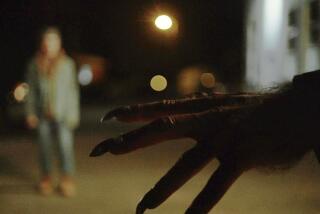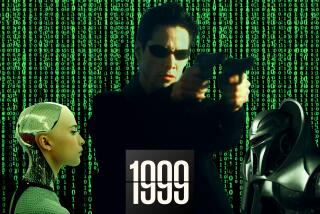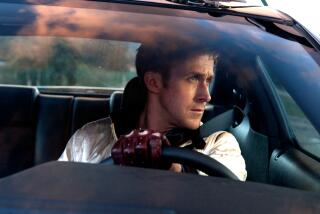Movie Sneaks: Michael Mann: obsessive, but don’t call him a stylist

Michael Mann moves with purpose. His compact frame exudes a coiled energy as he swiftly crosses his Santa Monica offices on a recent afternoon, taking a break from final adjustments on “Blackhat,” a suddenly timely thriller set against international cyber-crime.
Taking a seat at a small, functional table, he examines a note handed to him by an assistant and makes a quick judgment regarding whatever message it conveys. As an interview begins he switches on an audio recorder of his own.
“I record these things too, in case by accident I say something that’s half-smart,” he says.
There’s nothing accidental or half about any of it. Mann, 71, crafts sharp, sleek thrillers with a moody, existentialist bent. He is a four-time Oscar nominee, and from his early films “Jericho Mile,” “Thief” and “Manhunter” to “Heat,” “Collateral,” “Miami Vice” and “Public Enemies” he has combined an interest in authenticity with a flair for stylization that makes him a precursor and parallel to exacting filmmakers such as David Fincher and Christopher Nolan.
“Blackhat,” opening Jan. 16, begins with an exhilarating journey — and Mann’s most extensive, ambitious use of CGI effects — through the microscopic world of electronic impulses moving across networks, traversing the globe as marauding hordes of information.
Mann’s ongoing interests in detailed process and people at work, how things get done, alongside examinations of the hidden worlds of crime and power, all take root in “Blackhat.” Less than two minutes into an interview and he explains the interior architecture of microchips and how energy, and in turn data and malware, move across them.
“There was something spooky and very dramatic to me, and quintessential, in inanimate things moving to make things happen,” he says. “It’s very exciting, this concept of what a piece of code, what it does, how it defeats defenses.”
Chris Hemsworth (“The Avengers”) plays Nicholas Hathaway, a convicted computer hacker furloughed from federal prison to assist in an investigation of a series of cyber-attacks. A Chinese nuclear power plant and a commodities exchange in Chicago have been electronically invaded for mayhem and money and no further apparent motive.
A joint investigation is overseen by an FBI agent (Viola Davis) and a Chinese military officer (Leehom Wang), Hathaway’s former MIT roommate. After Hathaway is pulled in, he falls for his friend’s sister (Tang Wei), a network engineer, as they all try to discern a motive and the clues that lead them to the enigmatic villain Sadak (Yorick van Wageningen).
Mann’s storytelling is rooted in deep research. For “Blackhat,” written by Morgan Davis Foehl, Mann became intrigued by the Stuxnet virus, an extremely sophisticated and malicious stealth program that caused havoc not just on computer systems but also on the real-world equipment those computers monitored and controlled.
“That was an awakening for me that we don’t live the lives we think we do,” he says. “We don’t go into our homes and close the doors and close the windows and we’re private and everything’s fine. We are totally swimming in a sea of interconnectedness.”
The recent attacks on Sony have put the physical manifestations of cyber-crime in the headlines in the last few months. Yet as Mann’s project was underway, “This was just two or three years ago, and people didn’t know what I was talking about.”
He rattles off many people he met with in his research — engineers of microchips, counter cyber-intrusion experts, hackers turned security experts, steelworkers and inmates in a maximum-security prison.
“I like doing immersive research,” he says. “You bring yourself into a culture to the point where you can get some semblance of an understanding of the patterns and the rhythms and the mores and the values and how people think, how they feel, what do they want. I like that journey.”
With his brooding heroes and interest in design, architecture and technology, Mann has long often been referred to as a “stylist.” Yet he has largely downplayed that aspect of his filmmaking — “style is a dirty word” he said around the time the television show “Miami Vice,” which he executive produced, was an era-defining hit.
His recent films have been marked by a change in aesthetics: his close-ups feel a little too close, the rhythms of his editing more jagged, all in service of giving the films a heightened rush of immediacy. In part this seems to come from his early adoption of shooting on digital formats, with their lightweight cameras and ability to shoot with low light levels.
“Blackhat” was shot over 66 days in the U.S., Hong Kong, Malaysia and Indonesia, and the production used a variety of cameras, from top-of-the-line digital equipment to cheaper, smaller consumer-grade models. Cinematographer Stuart Dryburgh, an Oscar nominee for his work on “The Piano” who first worked with Mann on the pilot for the recent TV series “Luck,” noted that as much as possible they shot using available light, whether the dazzling neon of Kowloon or mostly by torchlight for the final confrontation in Jakarta. That sequence re-creates the annual Balinese Nyepi Day celebration with some 3,000 extras.
“The locations drove the look, very much,” says Dryburgh.
“I don’t know if Michael said this or whether this was my interpretation of it,” Dryburgh adds, “but I would say certainly in my mind, we were trying to make a crime story that was as gripping as ‘Heat’ in a sort of more intimate photographic style as in ‘The Insider.’ The camera is very mobile, it follows characters closely, which is a thing that Michael has become very interested in.”
Mann acknowledges the changes but not for the reasons one might expect. “Not because of digital,” he says. “The two aren’t related.”
Rather, he says, “I continue to evolve. There’s a way of composing shots and cutting that were particularly suited to ‘Last of the Mohicans’ that I wouldn’t be that interested in today. Like everybody else on the planet, I’m flooded by media and we are much more sophisticated about things.
“This is not theory generating practice,” he added, “this is just kind of an organic observation and me trying to figure out why I like this.”
Twitter: @IndieFocus
More to Read
Only good movies
Get the Indie Focus newsletter, Mark Olsen's weekly guide to the world of cinema.
You may occasionally receive promotional content from the Los Angeles Times.







